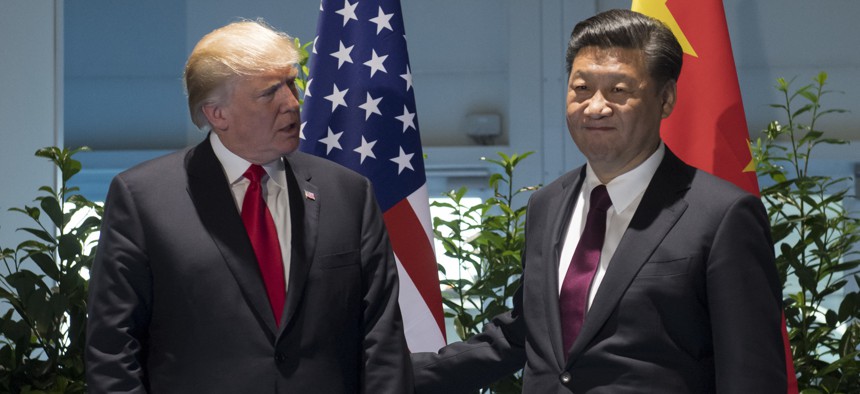
US President Donald Trump and Chinese President Xi Jinping, right, arrive for a meeting on the sidelines of the G-20 Summit in Hamburg, Germany, Saturday, July 8, 2017. Saul Loeb/AP
Can North Korea Drag the US and China Into War?
History offers clues about the likely course of a dangerous dynamic in east Asia.
Amid the exchange of threats between North Korea and the United States, ongoing North Korean nuclear and missile tests, and U.S. talk of “all options,” there is growing concern about the real possibility of war with North Korea. What many have not yet reckoned with is an even darker specter. Could events now cascading on the Korean Peninsula drag the U.S. and China into a great-power war?
The good news is that no one in a position of responsibility in either the U.S. or Chinese government wants a military conflict. Everyone knows that war between the world’s two largest economies would be catastrophic. This leads many observers to conclude that war between the U.S. and China is inconceivable.
But when we say that something is inconceivable, we should remind ourselves that this is a claim about what we can conceive—not about what is possible in the world. To stretch our imaginations, we need look no further than history.
While history never repeats itself, as Mark Twain observed, it does sometimes rhyme. So we should ask: What past events resemble the current predicament posed by North Korea’s nuclear advance, and how can they provide perspective on what we are now seeing—or even clues to what may happen?
History offers many examples of smaller third parties dragging larger powers into war. This risk is particularly acute in cases where a rising power threatens to displace a ruling power. The ancient Greek historian Thucydides observed this dangerous dynamic more than 2,400 years ago when describing the causes of the war between a rising Athens and a ruling Sparta. This problem—Thucydides’s Trap—creates a special vulnerability for the primary competitors. Actions by third parties that would otherwise be inconsequential or readily managed can trigger cascades of reactions that end in wars no one wanted. In classical Greece, Corinth and Corcyra were the culprits; in 1914, a Serbian terrorist assassination of the archduke; and potentially North Korea’s nuclear quest today. Thucydides’s insight applies not only to a change in the overall balance of power, but also to shifts in a decisive dimension of military power.
Among the precedents that can illuminate risks these dynamics create in the ongoing North Korean crisis, three stand out: Korea 1950, World War I, and the recurring dilemma posed as an adversary approaches the nuclear threshold.
In discussion with a group of Chinese military officers in Beijing in June, I asked whether North Korea’s Kim Jong Un could drag China and the U.S. into war. One bright young PLA colonel responded: absolutely not. I then asked whether this had ever happened before. He thought not—but then several of his colleagues reminded him of what happened in 1950.
In that case, Kim Jong Un’s grandfather, Kim Il Sung, launched a surprise attack on South Korea. His troops drove down the Korean Peninsula to the point that they were on the verge of reunifying the country. At the last minute, the U.S. came to South Korea’s rescue. An American division under the command of General Douglas MacArthur pushed North Korean troops back up the peninsula. MacArthur’s troops crossed the 38th parallel (which had been the dividing line between the North and South at the end of World War II) and were rapidly approaching the Yalu River that marks the border between Korea and China. But then, to MacArthur’s amazement, China attacked. A peasant army beat American troops back down the roads that they had come up, back down to the 38th parallel, where the U.S. was forced to settle for an armistice.
When the war ended, more than 50,000 Americans, several hundred thousand Chinese, and millions of Koreans had perished.
As my Chinese interlocutors noted, that was less than a year after Mao had won China’s long, bloody civil war. At that point, China’s GDP was less than 1/50th that of the U.S. And the U.S. was the world’s sole nuclear superpower, who had just five years earlier dropped atomic bombs on Hiroshima and Nagasaki to force Japan’s surrender in World War II. Today, China’s economy has already overtaken America’s in size, and China has nuclear weapons of its own. The proposition that China will not tolerate a unified Korea that is a U.S. military ally is, from the Chinese perspective, a simple settled fact.
While U.S. Secretary of Defense James Mattis’s testimony before the House Armed Services Committee in June emphasized that any war in Korea will be “catastrophic,” he also confidently stated in August that war with North Korea would mean “the end of its regime and the destruction of its people.” But what Mattis did not address—and what no member of Congress has asked him to address—is: What about China?
The U.S. sees China’s reluctance to rein in its troublesome ally, and its attempt to squeeze South Korea over its deployment of missile defense systems as seriously as it is squeezing North Korea, as evidence of a China that is trying to use the crisis to push the U.S. out of its neighborhood.
For China, American actions in dealing with North Korea are part of a larger mosaic in which the U.S. is seeking to contain the natural growth of Chinese power; to persuade South Korea and Japan to deploy missile defenses—including THAAD and Aegis systems—to erode China’s nuclear deterrent threat against the U.S.; and to enlarge the U.S. alliance system to include others, even India, in a strategy the U.S. calls “hedging” against China—which is operationally indistinguishable from containment.
And no one should forget that U.S. allies also have deep national interests at stake in this crisis. This multiplies the number of third parties that could pull the U.S. and China into war, just as Britain and Germany were drawn by smaller powers in to what became World War I.
For South Korea, the priority in this drama is to avoid war in its immediate neighborhood. As South Korean President Moon Jae In said recently: “I can confidently say there will not be a war again on the Korean Peninsula.”
Meanwhile, Japanese Prime Minister Shinzo Abe’s agenda in dealing with developments in North Korea focuses on two overriding objectives. First, he opposes any U.S. action that could trigger a North Korean attack on Japan, especially by a missile carrying a nuclear warhead. Second, he is using the heightened sense of risk among Japan’s citizens to advance his deep commitment to revise the pacifist constitution the U.S. imposed on Japan after World War II, and to rebuild a military to levels commensurate with Japan’s position as the third largest economy in the world.
With so many competing perspectives in this multi-party odyssey, risks that one or more of the parties misunderstand what the others are doing increase exponentially.
World War I offers the classic analogy. How could the assassination of Austrian Archduke Franz Ferdinand have provided the spark for a conflagration that ended in such devastation it required historians to create an entirely new category: World War? A century after that event, historians are still wrestling with that question.
The two centennial books that do the most to advance this debate are Chris Clark’s The Sleepwalkers and Margaret MacMillan’s The War That Ended Peace. Both note the deeper forces driving events in the decade running up to 1914, including in particular a rising Germany that challenged Britain’s rule. But both also emphasize the contingent choices leaders made—without fully seeing the consequences their actions would bring.
At the end of the “Great War,” what had happened to every one of the principal actors and his primary objectives? All of them had lost what they cared about most: the Austro-Hungarian emperor ousted and his empire dissolved; the Russian czar, who had attempted to support fellow Slavs in Serbia, overthrown by the Bolsheviks; the German kaiser, who had supported his only ally in Vienna, dismissed; France bled for an entire generation never to recover as a great power; Britain shorn of its treasure and youth, a nation that for a century had been the world’s creditor turned into a debtor on a path to slow decline. Had they been given a chance for a do-over, none of the leaders of the major states in 1914 would have made the choices he did. But they did, and war between great powers happened.
Similar tensions and fears to those that drove Britain and Germany along the road to World War I also emerge when an adversary approaches a decisive threshold in military power. Since the advent of atomic weaponry in 1945, there have been seven cases in which a state stood on the threshold of acquiring nuclear weapons that would pose a genuine existential threat to its adversary. In each case, its nuclear-armed competitor seriously considered a military attack to prevent that happening. In late 1949, after the Soviet Union tested its first atomic device, the U.S. Air Force chief of staff urged President Truman to authorize a strike to disarm Moscow. As China approached the nuclear tipping point in the early 1960s, the Soviet Union planned to attack Beijing and even consulted the U.S. about the option. As India approached the threshold, China also considered military strikes; as Pakistan did so, India considered striking; and now, as North Korea continues its weapons development, the U.S. is publicly invoking the military option. In all of these cases, as a government weighed the potential consequences of attack versus living with a nuclear-armed adversary, it chose the latter.
Only one state executed military plans to prevent an adversary from getting nuclear weapons: Israel. In 1981, it destroyed an Iraqi nuclear reactor at Osirak before it could produce plutonium. In 2007, it destroyed a nuclear reactor North Korea had sold to Syria, one that would by now have produced enough plutonium for several nuclear weapons. In neither of these cases, however, had Israel’s adversary yet acquired nuclear weapons, and in both cases it had only one target to destroy. In contrast, North Korea already has by one estimate up to 60 nuclear weapons today, and in the words of former Air Force Chief of Staff Merrill McPeak, destroying all of North Korea’s hidden nuclear facilities could require a “house-to-house search.”
What insights or clues can we glean from these cases for dealing with the North Korean crisis today? As the most influential modern practitioner of applied history, Henry Kissinger, has cautioned, “History is not, of course, a cookbook offering pretested recipes.” Instead, it can “illuminate the consequences of actions in comparable situations.” The intellectual challenge for “each generation is to discover for itself what situations are in fact comparable.”




